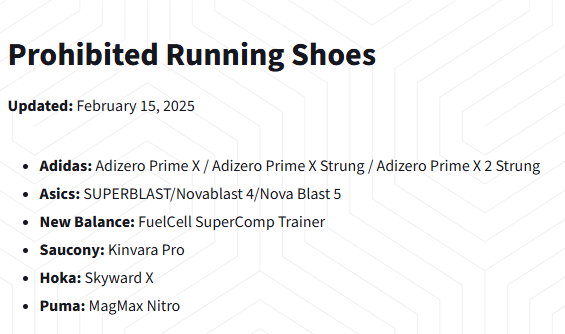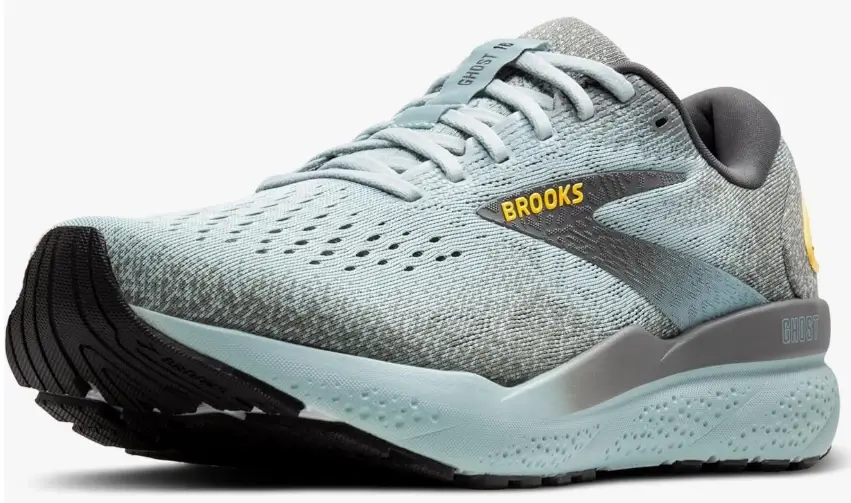In 2017, Nike’s Vaporfly shoes sparked a revolution in running—and a firestorm in endurance sports. By 2023, Ironman had drawn a line in the sand, banning certain “super shoes” to preserve fair competition. This article dives into the banned technology, ironman forbidden shoes, the rules, and the high-stakes debate over innovation vs. fairness. Whether you’re an athlete, a tech enthusiast, or a sports fan, here’s everything you need to know about the illegal running shoes that Ironman banned.
For the asics lovers, the asics Novablast 4 and Novablast 5 are both banned from ironman event due to excessive cushioning.

Ironman Banned Running Shoes List:
- Adidas: Adizero Prime X / Adizero Prime X Strung / Adizero Prime X 2 Strung
- Asics: SUPERBLAST/Novablast 4/Novablast 5
- New Balance: FuelCell SuperComp Trainer
- Saucony: Kinvara Pro
- Hoka: Skyward X
- Puma: MagMax Nitro
Highly Recommended Legal Running Shoes
“As an Amazon Associate I earn from qualifying purchases.”
| Shoe Model | Key Features | Stack Height | Best For |
| Nike Vaporfly 3 | Carbon plate, ZoomX foam, lightweight | ~40mm | Racing, all distances |
| Nike Alphafly 3 | Max-cushion, Air Pods, carbon plate | ~40mm | Long-distance, Ironman |
| ASICS Metaspeed Sky Paris | Turbo FlyteFoam+, carbon plate, very light | 39.5mm | Mid/forefoot runners |
| ASICS Metaspeed Edge Paris | Carbon plate, designed for cadence runners | 39.5mm | Fast turnover runners |
| ON Cloudboom Strike | Carbon Speedboard®, max cushioning | 39.5mm | Forefoot runners |
| Salomon S/Lab Phantasm 2 | Energy Blade, lightweight, stable | <40mm | Race-day, stability |
| Brooks Hyperion Max 2 | Responsive, lightweight, no carbon plate | <40mm | Versatile, training/race |
| New Balance FuelCell SuperComp Elite V4 | Full carbon plate, lightweight upper | 40mm | Forefoot runners |
Additional Legal Options
- Nike Pegasus: Reliable, moderately cushioned, suitable for training and racing.
- Brooks Ghost: Trusted daily trainer, comfortable for longer distances.
- ASICS Gel-Nimbus 26: Highly cushioned, legal for both racing and training.
- Saucony Endorphin Pro 4: Carbon plate, legal stack height, popular among triathletes.
Ironman Forbidden Shoes: Nike Vaporfly & Alphafly
The Nike Vaporfly and Alphafly are the most notorious shoes banned by Ironman. These models feature:
- Carbon Fiber Plates: Rigid, spoon-shaped inserts that act like springs, propelling runners forward.
- High-Stack Midsoles: Thick foam layers (over 40mm) for energy return, reducing muscle fatigue over long distances.

Why They Dominated Races
Studies show these shoes improve running economy by 4-6%—a game-changer in elite racing. At the 2019 Ironman World Championship, 31 of 32 podium finishers wore Vaporflys.
Why Ironman Banned These Shoes
Ironman’s Shoe Regulations Explained
- Stack Height Limit: 40mm maximum midsole thickness (measured vertically).
- No Embedded Plates: Shoes cannot contain more than one rigid carbon plate.
“Equipment must not provide unfair advantage,” states Ironman Rule 3.4.
The Fair Play Argument
Ironman argues the shoes skewed results, letting technology eclipse training. A 2022 study found Alphaflys could shave 8+ minutes off a marathon time—critical in races decided by seconds.
Controversy: Innovation vs. Regulation
For the Ban:
- Pros: “Levels the field for athletes without sponsor deals.” — Age-group triathlete survey.
Against the Ban:
- Cons: “Progress is inevitable. Should we ban lighter bikes too?” — Running tech engineer.
Ironman Shoe Rules: A Deep Dive
Stack Height: How It’s Measured
Ironman uses a vertical measurement from the outsole to the top of the midsole (excluding the insole). Shoes are tested pre-race with a calibrated gauge.
Enforcement & Penalties
- Pre-Race Checks: Officials randomly inspect shoes at major events.
- Disqualification: Using banned shoes leads to DQ. In 2022, two pros were removed mid-race.
Impact on Athletes: What You Need to Know
For Pros
Elites like Lucy Charles-Barclay switched to compliant models like the Saucony Endorphin Pro 3 (38mm stack).
For Amateurs
- Check Your Gear: Use Ironman’s 2023 Approved Shoe List.
- Top Legal Picks:
- Hoka Carbon X 3 (38mm)
- ASICS Metaspeed Sky+ (37mm)
- New Balance FuelCell SC Elite v4 (39mm)
The Future of Shoe Tech in Ironman
- Loophole Alert: Brands are experimenting with non-carbon plates (e.g., Pebax) to mimic bounce without breaking rules.
- Rule Updates: Ironman may cap energy return (a.k.a. “foam rebound percentage”) next.
FAQ: Your Questions Answered
No—only those exceeding 40mm stack height or using multiple plates.
Yes! Most marathons still allow them.
Unlikely. The 40mm cap aligns with World Athletics standards.
Yes, asics novablast 4 is banned from ironman events, due to excessive cushioning.
Conclusion
The illegal running shoes that Ironman banned represent a pivotal moment in sports: How much tech is too much? For now, athletes must balance speed and compliance. As shoe brands innovate, one truth remains—the best gear can’t replace grit, sweat, and miles of training.



Pingback: Beginner Triathlon Training Plan: Your 12-Week Guide to Race Day - besttriathletes.com
Pingback: From Triathlon to Marathon: Alex Yee’s Impressive 14th Place Finish in London - besttriathletes.com
Pingback: Complete 24-Week (6-Month) Half Ironman 70.3 Training Plan Program - besttriathletes.com